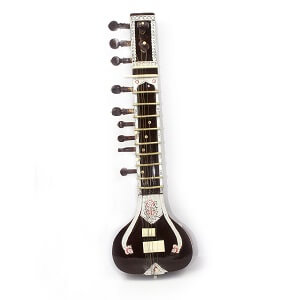Sitar
 In the western world the sitar is perhaps the most well known musical instrument of India. It’s sound evokes thoughts and feelings of the sub-continent. It is believed to have evolved into its present form in the 1700’s, during the collapse of the Moghul Empire, as a marriage between the Persian Setar and the South-Indian Vina, while using the characteristically resonant bridge of the Tampura.
In the western world the sitar is perhaps the most well known musical instrument of India. It’s sound evokes thoughts and feelings of the sub-continent. It is believed to have evolved into its present form in the 1700’s, during the collapse of the Moghul Empire, as a marriage between the Persian Setar and the South-Indian Vina, while using the characteristically resonant bridge of the Tampura.
There is a common story attributing the invention of the sitar to Amir Khusru. Amir Khusru was a great personality and is an icon for the early development of Hindustani Sangeet (North Indian classical music). He lived around 1300 AD. As common as this story is, it has no basis in historical fact. The sitar was clearly nonexistent until the time of the collapse of the Moghul Empire.
Some suggest that the sitar is derived from the Saraswat ior Khachappi vina. This is at least a possibility. Still there are questions raised. There is a possibility that the lute class of chordophones is not indigenous to India but was imported from outside. But the use of Gourd for sound box the metal oval frets and also the temple carvings strongly suggests that it is an adaptation of some kind of veena with some present day modification.
The most striking feature of the Sitar’s playing technique is it’s main strings capacity for being pulled or bent. On one fret the main string can be pulled downward at least a fourth; for example from C to G. This particular feature has only been available during the last fifty years – since steel strings have been made with enough strength to withstand such tension. This pulling capacity allows the instrument to accurately emulate the gliding effect of vocal music.